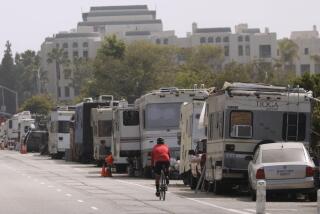L.A. -- from park poor to park rich, one park at a time
Two quiet events happened in December that signal an important ongoing change in the landscape and in life in Los Angeles: The city opened two more parks in its 50 Parks Initiative, parks 20 and 21. On Dec. 7, the Drum Barracks Park was unveiled across from the Drum Barracks Civil War Museum in Wilmington, and on Dec. 19, the Wall Street Park opened at Wall Street and Manchester Boulevard in South L.A. These beautiful places are the latest installments in what will be more than 50 new parks over the next couple of years.
Los Angeles has always been known as “park poor.” Overall, that is a bum rap. Independent surveys of the quantity of recreational open space in the region and within the city limits show a wealth of parkland on a per capita basis. With mountains, beaches and the spectacular 4,300-acre Griffith Park, we are blessed with great places to play and relax. But for too many Angelenos, life in our far-flung city is park poor because these assets are far from their homes, and transportation to the parks is difficult. In older parts of town there are many dense miles of residences and commercial properties unbroken by green spaces.
We are changing that.
Starting two years ago, the city Department of Recreation and Parks took advantage of a drop in real estate prices during the recession to acquire, through purchase and donation, residential parcels and vacant land on which to place new neighborhood parks in the places they are most needed. The department came up with a total of 181 acres at 51 sites. For example, the lovely Wall Street Park, with its established avocado tree, playground, adult fitness equipment, native plants and security systems, had been an abandoned house and eyesore occupied by squatters until it was donated to the city by JPMorgan Chase and redeveloped as a park with a donation from the L.A. Parks Foundation.
This park and the others in the 50 Parks Initiative provide a pleasant, safe place for adults and children, particularly those whose needs are most often neglected. But the parks are more than that; they are boosts for the community that surrounds them, replacing blight with a neighborhood resource that raises the values of nearby homes. They are designed with drought-resistant native plants, solar-operated trash compactors and long-lasting LED lighting to preserve water and energy.
The size of the parks, many of which are less than an acre, is not the key to success. It is their proximity to where the need is, coupled with their unique features.
The Drum Barracks Park, built on reclaimed land that had been an oil well site and donated by Warren Resources of California, does all of these things and teaches some fascinating history. It includes statues of camels once quartered at the site and at the drum barracks during the Civil War. It will become home to living history displays programmed by the museum across the street.
Each of the new parks is different, and tailored to the wishes of the people who will use it. The city selected sites that are in the neediest areas economically and farthest from existing recreational land. Consultation with communities to assure a park is wanted and to learn what residents want in the park is the most time-consuming as well as the most important part of the process.
This is a permanent change. Under the City Charter, once the land is dedicated to park use, it may never be taken away.
The initiative is large enough to make a dent in the so-called park poor reputation of our city and to improve the lives of many people. But we need more. We must also establish larger parks with open spaces and sports fields. We need to add to and improve recreation centers and swimming pools. We need to return funding to the department to ensure that all of the city’s treasures are maintained properly and the recreation programs are growing.
When it comes to neighborhood parks, there is no reason we cannot increase this program to 100 parks. If we do that, we can reach the point at which neighborhood parks are considered a normal amenity in every community. We can transform Los Angeles.
Barry Sanders is president of the Board of Commissioners of the Recreation and Parks Department of the city of Los Angeles and chairman of the Los Angeles Parks Foundation.
More to Read
A cure for the common opinion
Get thought-provoking perspectives with our weekly newsletter.
You may occasionally receive promotional content from the Los Angeles Times.










